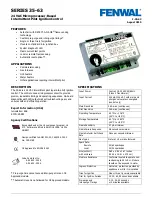
Effective: August 2015
4
F-35-63
TROUBLESHOOTING
Note:
During a fault condition, the LED will flash on for
1/4 second and off for 1/4 second as needed to
indicate the fault code. The code will repeat every
3 seconds. Removing power from the control will
clear the fault code.
Internal Control Failure
If the control detects a software or hardware error, all outputs
are turned off and the LED displays a Steady On condition. If this
condition persists after an attempt to restart, then the control
must be replaced.
Proper Electrode Location
Proper location of electrode assembly is important for optimum
system performance. The electrode assembly should be located
so that the tips are inside the flame envelope and about 1/2-inch
(1.2 cm) above the base of the flame as shown:
Notes:
•
Ceramic insulators must not be in or close to the flame.
•
Electrode assemblies must not be adjusted or
disassembled. Electrodes are NOT field adjustable.
•
Electrodes should have a gap spacing of 0.125± 0.031
in (3.12± 0.81 mm), unless otherwise specified by the
appliance manufacturer. If spacing is not correct, the
assembly must be replaced.
•
Exceeding temperature limits can cause nuisance
lockouts and premature electrode failure.
•
Electrodes must be located where they are not exposed
during normal operation.
Flame Current Measurement
Flame current is the current that passes through the flame from
sensor to ground. To measure flame current, connect a True
RMS or analog DC micro-ammeter to the FC+ and FC- terminals.
Readings should be 1.0 µ
A
DC or higher. If the meter reads
negative or below "0" on scale, meter leads are reversed. Re-
connect leads with proper polarity.
Alternately, a Digital Voltmeter may be used to measure DC
voltage between FC+ and FC- terminals. Each micro-amp of
flame current produces 1.0 VDC. For example, 2.6 VDC equates
to 2.6 µ
A
.
A good burner ground that matches the control ground is critical
for reliable flame sensing.
Troubleshooting Guide
Symptom
Recommended Actions
1. Control does not start
A. Miswired
B. 24 VAC transformer fault
C. Fuse circuit breaker fault
D. Faulty control, check LED
for fault codes
2. Thermostat on - no spark
A. Miswired
B. Faulty thermostat, no
voltage at thermostat
terminal TH/W
C. Faulty control, check LED
for fault codes
3. Valve on - no spark during
TFI
A. Shorted electrode -
establish 1/8-inch gap
B. Check high voltage cable
C. Miswired
4. Spark on - valve off
A. Valve coil open
B. Valve wire disconnected
C. Faulty control, check
voltage at gas valve
terminals PV1 or MV1 and
V2
5. Flame okay during TFI - no
flame sense after TFI
A. Check electrode position
B. Check high voltage wire
C. Poor ground at burner
D. Poor flame, check flame
current
Fault Conditions
LED Indication
Fault Mode
Steady On
Internal Control Failure
2 Flashes
Pilot flame without call for heat
3 Flashes
Ignition Lockout
























